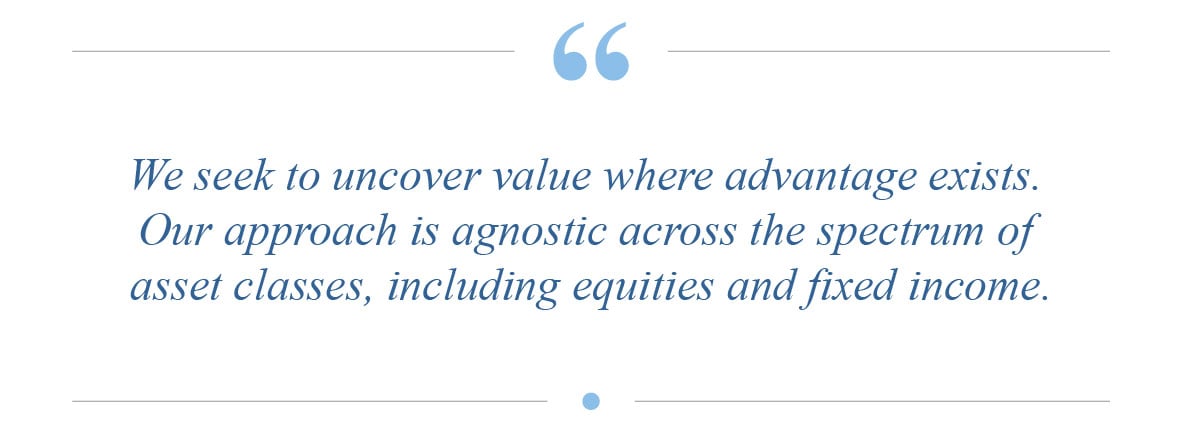In a world where it’s often easier to assimilate than forge a new path, Westwood is committed to active investing with uncommon approaches that are outliers in our industry — all with the goal of delivering performance and alpha for our clients in all market environments. Our Multi-Asset strategies are an example of how Westwood’s managers utilize research and proprietary processes to create a product that strives to harmoniously complement most investors’ portfolios, especially when it comes to downside control, decorrelation and diversification. We seek to uncover value where advantage exists. Our approach is agnostic across the spectrum of asset classes, including equities and fixed income.

Adapting to a Changing Market
Prior to the pandemic, the last decade brought record returns in stocks, bonds and other asset classes, with relatively low volatility and high correlation. In other words, for several years, it was relatively easy to produce excess return (or at least achieve above-average beta) compared to benchmarks, by employing generic, long-bias traditional investment vehicles.
Unfortunately, even prior to the pandemic, economic growth forecasts had fallen along with interest rates, which are expected to remain low. These factors, combined with predictions for higher volatility, are cause for anticipating difficulty in consistently achieving alpha in market-bias style strategies.
History has shown that during a crisis, there is generally increased correlation between stocks, sectors and asset classes. Knowing this, investors may flock to gold or the safety of bonds or abandon growth stocks during slower economic times or in crisis. Interestingly, immediately following a crisis, we have seen generally significant disconnects, or decorrelation. We believe an agnostic approach could serve investors well in this scenario. This enables a manager to take a defensive stance, diversifying across asset classes and focusing on being well-positioned to take advantage of dislocation as a result of decorrelations.
Westwood's Answer
At Westwood, we use an innovative bottom-up process that aligns with our top down macro views when selecting investments for our Multi-Asset strategies. With decades of experience, technological capabilities and tactical allocation decisions, we strive to produce consistent results within our risk mandate. Our team approach also ensures a more comprehensive analysis process that leaves few stones left unturned as we seek opportunities across multiple sectors.
Beyond Bottom-Up
Using a dual, hybrid methodology, driven both by objective and subjective data, we take a unique approach and examine targets from both bottom-up and top-down perspectives. This panoramic perspective allows us to create a more balanced, complete thesis. By removing the proverbial strategic “blinders,” we can better identify valuation differences with the goal of shielding the portfolios from economic distress, reduce return volatility and, importantly, secure potential upside.
With our top-down, bottom-up approach, we design our portfolios with the goal of achieving the most efficient alpha in the most attractive market areas. From there, we set and engage in the highest value selections on an investment. Within both the top-down positioning and investment selection component, we rely on an in-house system to generate exclusively available, bottom-up valuation signals. This approach differentiates our investment style and makes our Multi-Asset franchise truly unique. For the top-down analysis, we leverage our evergreen, proprietary model that transforms many individual security forecasts into a broad market signal. In our specific selection phase, we rely on fundamental analysis from highly focused analysts.
Downside Is a Priority
It is common industry practice for analysts to focus heavily on the upside, as the majority of investors seek capital appreciation. With that in mind, we assign one- and three-year price targets to an asset. In addition, we formulate a potential downside price for each company.
By forming a “worst-case” scenario, we can better determine potential volatility of a holding and how it may affect the broader portfolio if things do not go as planned. This idiosyncratic approach may sound unusual, but it has proven itself useful in both flat markets and highly volatile environments. Since markets are unpredictable, a downside plan can help us limit risk when things don’t go “as planned.”
Dynamic Signals
We don’t wait for others to change their minds in order to change ours. Our models are routinely tested to assess upside and downside capture, beta and the alpha potential of every holding within our portfolios. If targets are met or if a thesis or catalyst materially changes, our team will adjust a position to match the appropriate potential or risk. All assets are dynamically measured against their peers, the sector, the market and to other holdings within the portfolio to maintain an appropriate risk profile.
And while we are long-term investors, we may exit a position that has reached its target, especially when more compelling opportunities exist.
Portfolio Construction Routinely Assessed
With the ability to hold different types of assets, we routinely screen opportunities and examine risk or liquidity premiums as our portfolio evolves along with the global economic landscape.
Our portfolio managers monitor analysts’ price targets and track potential positive or negative thesis changes. Final investment decisions are made at the intersection of technology and data-driven insights, with the subjective evaluation from a well-informed, highly experienced team.
Key Return Drivers:
- Capital Appreciation – Discovering uncovered value across a broad field of securities
- Income Producers – Longer-term positioning in higher-yielding assets
- Event Risk Play – Focusing on a particular catalyst within a specific time frame that is likely to generate outperformance
Putting It All Together
One example of how we apply these key return drivers might be an upcoming change in legislation that we believe is likely to impact a group of stocks (macro); we would apply proprietary criteria to target the asset most likely to benefit from that catalyst when compared to its peers. Put simply, our consistent and repeatable process narrows down the best candidates using external data, proprietary modeling, and most importantly, bottom-up, fundamental analysis from our internal analyst team.
Why Tactical Multi-Asset
Multi-Asset strategies can combine multiple asset classes including stocks, bonds, cash equivalents and other instruments to offer investors a unique risk profile tailored to meet specific goals. Our team deploys Multi-Asset strategies composed primarily of equity, debt and cash, supported by an innovative, proprietary formula.
We agree with the CFA Institute, which recently termed Multi-Asset strategies “the decathlons of the investment industry.”* They not only tap and combine a myriad of skills and disciplines, but often require high-touch oversight that might differ from your standard index-like strategy or even sector-focused investments such as “LargeCap.” Tactical Multi-Asset strategies like Westwood’s approach may be most beneficial when markets are more difficult to navigate. With expectations for lower returns, higher volatility and increased economic uncertainties, our Multi-Asset approach may help achieve alpha where it’s most needed.

